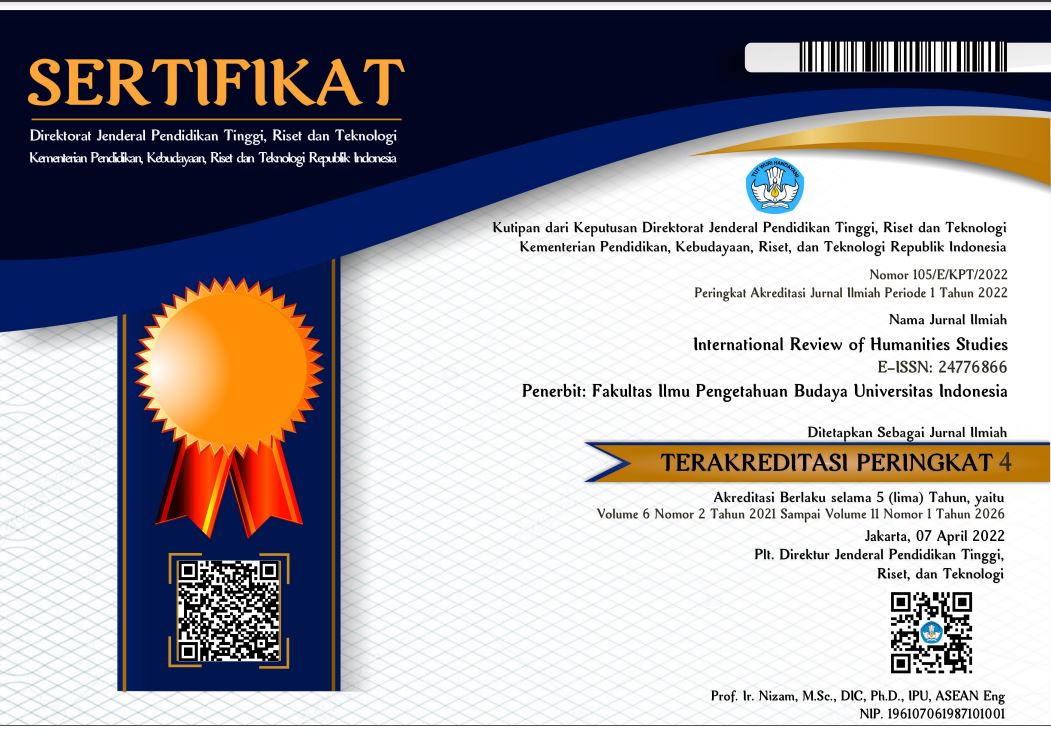International Review of Humanities Studies

Abstract
This article examines Tek Seng Bio (德圣庙) Temple within the context of the temple as the symbol of local history among Chinese Indonesians in Cikarang. Established in 1900 by Tjio Lo Weh (蒋維内) from Fujian, the temple marked the inception of a Chinese settlement in North Cikarang. Unique in its devotion to Lín Tài Shī Gōng/Liem Tay Soe Kong (林太师公) as their main deity, Tek Seng Bio Temple originally functioned as a private familial place of worship. However, its transition to a public worship house faced challenges in 1967, with Presidential Instruction Number 14 imposing restrictions on Chinese religious practices, citing negative psychological and moral impacts on Indonesian society. In response to the governmental order, Tek Seng Bio Temple transformed itself into Dipankara Monastery in 1984. This adaptation facilitated the convergence of Theravada and Tridarma Buddhist worship, accommodating adherents of Confucianism and Taoism. Dipankara Monastery serves as a focal point for Chinese Buddhists, emphasising ancestor worship and traditional celebrations. Concurrently, Sariputra Monastery, established in 1991 adjacent to Tek Seng Bio Temple and even briefly occupying the front yard of Tek Seng Bio Temple before Sariputra had their own building, focuses on spiritual worship and education for pure Theravada and Chinese Buddhists in North Cikarang. This pioneering research constitutes the first comprehensive exploration of Tek Seng Bio Temple’s locality. Utilising primary source interviews, archival documentation, photographs, and fieldwork research, the study aims to contribute to the local historiography of North Cikarang, enhancing historical insights into the Chinese, Buddhist, Confucian, and Taoist communities in Indonesia. By meticulously examining the temple’s evolution and adaptation to external constraints, this research seeks to enrich our understanding of the complex interplay between religious practices, governmental regulations, and the cultural identity of Chinese Indonesians in Cikarang.
References
Bentley, J. (1993). Old World encounters: Cross cultural contacts and exchange in pre-modern times. Oxford University Press.
Chao, S. H. (1987). Confucian Chinese and the Gospel: Methodological considerations. Asia Journal of Theology. 1(1), 17–33.
Cheuk Yin, L., & Xin Ying, Y. (2018). 漂洋过海: 林偕春与新加坡的 林太师信仰/Across the seas: Lin Xiechun and the Lim Tai See belief in Singapore. Cogitatio: Journal of Sinological Studies 漢學研究學刊, 9(1), 197–222.
Confucius. (2000). The analects. Translator: Arthur Waley. Everyman Publishers.
Dewan Pandita Perkumpulan Majelis Agama Buddha Tridharma Indonesia. (2020). Pedoman kebaktian Tridharma.
Desprosianasari, L. & Hartati, C. D. (2019). Akulturasi dalam upacara ulang tahun dewa di Kelenteng Shia Djin Kong, Jonggol. Jurnal Bambuti: Bahasa Mandarin dan Kebudayaan Tiongkok, 1(2), 35–47
Dihni, V. A. (2022). Pemeluk Agama Konghucu di provinsi ini terbanyak nasional. Databoks Katadata. https://databoks.katadata.co.id/datapublish/2022/05/17/pemeluk-agama-konghucu-di-provinsi-ini-terbanyak-nasional.
Faisol, E., & Fuadona, F. (2015). Pengikut Agama Tao di Jawa Tengah terancam punah. Tempo. https://nasional.tempo.co/read/666289/pengikut-agama-tao-di-jawa-tengah-terancam-punah.
Gottschalk, L. (2008). Mengerti sejarah. Translator: Nugroho Notosusanto. UI Press.
Howell, M., & Prevenier, W. (2001). From reliable sources: An introduction to historical methods. Cornell University Press.
Ika Santhi Rahayu, S. D. (2005). Boen Bio: Benteng terakhir Umat Khonghucu. JP Books.
Ismaun. (2005). Pengantar belajar sejarah sebagai ilmu dan wahana pendidikan. Historia Utama.
Kurniawan, A. (2023, May 21). Pembuatan HU HWAT / HU PENG AN perayaan sejit Ym. Kongco. Liem Tay Soe Kong- Tek Seng Bio Cikarang [Video]. YouTube. https://www.youtube.com/watch?v=b-IEj6osy1k.
Kustedja, S., Sudikno, A., & Salura, P. (2014). Local Deities as symbol of acculturated Chinese diasporas temples in Indonesia. International Journal of Academic Research: Part A, Applied and Natural Sciences, 6(4).
Mahdi, M. I. (2022). Mayoritas Umat Buddha Indonesia berada di Jakarta. DataIndonesia.id. https://dataindonesia.id/varia/detail/mayoritas-umat-buddha-indonesia-berada-di-jakarta
Nadeau, R. L. (2010). Divinity. In Randall Laird Nadeau (Editor). The Wiley-Blackwell companion to Chinese religions (pp. 369–395). Blackwell Publishings.
Oktaliani, K. (2023, January 24). Menengok petilasan Raden Surya Kencana, sang penguasa Gunung Gede. Okezone. https://travel.okezone.com/read/2023/01/23/408/2751195/menengok-petilasan-raden-surya-kencana-sang-penguasa-gunung-gede.
Presiden Republik Indonesia. (1967). Instruksi Presiden Republik Indonesia Nomor 14 Tahun 1967 tentang Agama, Kepercayaan dan Adat Istiadat Cina. Regulasip. https://www.regulasip.id/eBooks/2018/December/5c02553e4d057/inpres_14_1967.pdf
Purcell, V. (1965). The Chinese in Southeast Asia. Oxford University Press.
Qìng Kūn, Y. (1961). Chinese society: A study of contemporary social functions of religion and some of their historical factors.
Rizki. (2021, Augustus 15). Polsek Cikarang Utara berikan 210 vaksinasi ke Yayasan Cakra Utama dan masyarakat Bekasi. Media Pasti. https://mediapasti.com/berita-covid-19/6515/polsek-cikarang-utara-berikan-210-vaksinasi-ke-yayyasan-cakra-utama-dan-masyarakat-bekasi/.
Setiono, B. G. (2002). Tionghoa dalam pusaran politik. Elkasa.
Susanto, J. (2023, October 14). Personal Communication. (Harry Farinuddin, Interviewer).
Syafi’i, I. (2023, May 2). Makam siapa yang berada di lereng Gunung Kawi, simak ceritanya.
Jatim Satu News. https://www.jatimsatunews.com/2023/05/makam-siapa-yang-berada-di-lereng_2.html.
Takakusu, J. (1896). A record of Buddhist practices sent home from the Southern Sea. Oxford University Press.
Utama, B. (2023, October 14). Personal Communication. (Harry Farinuddin, Interviewer).
Vimalanata. (1994). Riwayat terbentuknya pemakaman “Lauw Djin Hwee” dan terbentuknya Yayasan “Dharma Bhakti” Cikarang, Archives of Yayasan Dharma Bhakti Sariputra, Cikarang Utara.
Wang, C., & Madson, N. H. (2013). Inside China’s legal system. Elsevier.
Wang, R. (2013). The Chinese imperial examination system: An annotated bibliography. The Scarecrow Press.
Wen Chu, H. (2020). From man to God, from history to medicine: A local narration of the belief culture of Taishi Lin in Singapore/由人而神, 從史轉醫: 新加坡林太師信仰文化的在地敘說.
Journal of Chinese Literature of National Cheng Kung University/成大中文學報, (71), 125–160.
Waskey, A. (2013). Malay. In Steven Danver (editor). Native peoples of the world: An encyclopedia of groups, cultures, and contemporary issues (pp. 216–218). Routledge.
Yuanzhi, K. (2005). Silang budaya Tiongkok-Indonesia. PT Bhuana Ilmu Populer.
Recommended Citation
Farinuddin, Harry and Pradjoko, Didik
(2024)
"TEK SENG BIO TEMPLE AS A SYMBOL OF HISTORY AND LOCALITY OF THE CHINESE INDONESIAN COMMUNITY IN CIKARANG,"
International Review of Humanities Studies: Vol. 9:
No.
2, Article 2.
DOI: 10.7454/irhs.v9i2.1303
Available at:
https://scholarhub.ui.ac.id/irhs/vol9/iss2/2
Included in
Anthropology Commons, Art and Design Commons, Creative Writing Commons, Cultural Heritage Law Commons, Education Law Commons, Film and Media Studies Commons, History Commons, Intellectual Property Law Commons, International and Area Studies Commons, Legal Writing and Research Commons, Linguistics Commons, Museum Studies Commons, Philosophy Commons, Urban Studies and Planning Commons



